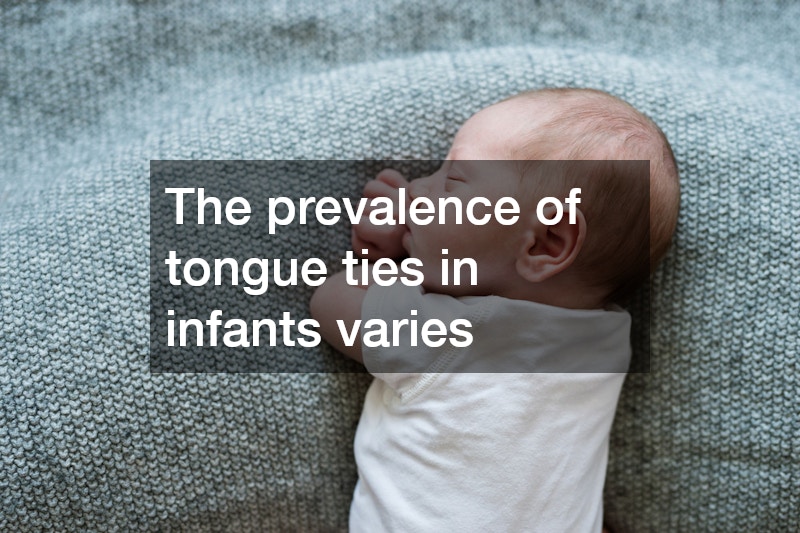
Tongue ties, medically known as ankyloglossia, occur when a baby is born with an unusually short, thick, or tight band of tissue tethers that the bottom of their tongue to the floor of their mouth. This condition can restrict the tongue’s movement and can lead to difficulties with breastfeeding, speech, and oral hygiene. Recognizing tongue ties early is crucial for the overall well-being and development of your baby.
The prevalence of tongue ties in infants varies, but it is reported to occur in 4-11% of newborns. Not all tongue ties cause problems, but many do require intervention to avoid complications. Healthcare providers can conduct a simple assessment to confirm if a tongue tie is present, usually during a routine newborn examination.
It’s important for parents to understand that not all tongue ties require treatment. Assessment by a lactation consultant or a pediatrician can help determine the severity and the impact on the baby’s ability to feed. Consulting with professionals helps ensure that any challenges related to tongue ties are identified and managed promptly and effectively.
Identifying the Signs and Symptoms
There are several signs that may indicate your baby has a tongue tie, including difficulties breastfeeding. Babies with tongue ties might struggle to latch onto the breast, and mothers may experience sore, cracked, or bleeding nipples due to improper latching. Additionally, babies may frequently fall asleep at the breast or seem hungry all the time because they cannot get enough milk.
Aside from feeding difficulties, tongue ties can also affect the baby’s ability to make certain sounds, potentially leading to speech delays or issues later in life. Parents might notice that their baby makes ‘clicking’ sounds while breastfeeding, which is another indicator of a poor latch due to restricted tongue movement. If you notice any of these signs, it is advisable to consult with a healthcare provider for a thorough evaluation.
Another sign of tongue ties is when the baby’s tongue appears heart-shaped or notched when extended. Sometimes the tongue might seem to be anchored or unable to lift properly, which is a common characteristic of tongue ties. Recognizing these symptoms early can lead to early intervention and treatment, preventing further complications as the child grows.
Seeking Professional Diagnosis and Evaluation
If you suspect that your baby has a tongue tie, seeking professional evaluation is the first step. A healthcare provider, such as a pediatrician, ENT specialist, or lactation consultant, is typically qualified to diagnose a tongue tie accurately. They may use a combination of physical examinations and parental feedback regarding feeding difficulties to make the diagnosis.
During the evaluation, the specialist will examine the baby’s mouth, looking for the presence and extent of the restrictive tissue. They will assess how the tongue movement is impacting breastfeeding, and may also discuss any concerns regarding speech and oral hygiene. Based on this evaluation, the healthcare provider will offer recommendations for any necessary interventions.
In some cases, a referral to a pediatric dentist or oral surgeon might be needed for a more comprehensive assessment. These specialists are trained in the anatomy of the mouth and can provide additional insights into the best course of action. Getting an accurate diagnosis is critical to ensuring your baby receives the appropriate treatment and care.
Exploring Treatment Options
Once a tongue tie is diagnosed, parents will need to consider the available treatment options. Not all tongue ties require surgical intervention; some may resolve on their own or improve over time with the assistance of a lactation consultant. However, if the tongue tie is causing significant feeding, speech, or oral hygiene issues, a procedure known as a frenotomy might be recommended.
A frenotomy is a simple, quick procedure that involves snipping the restrictive tissue under the tongue. This is typically done with minimal discomfort and can often be performed in a pediatrician’s office. The procedure allows for improved tongue movement and often offers immediate relief from breastfeeding difficulties.
In cases where a frenotomy is not sufficient or if the tongue tie is more complex, a more extensive procedure called a frenuloplasty might be needed. This surgery is more involved and often performed in a hospital setting under anesthesia. It’s important for parents to discuss all treatment options, the risks, and benefits with their healthcare provider to make an informed decision.
Post-Treatment Care and Monitoring
After treatment for a tongue tie, careful post-operative care is essential to ensure proper healing and success. Parents should follow the healthcare provider’s instructions regarding feeding, oral exercises, and wound care. Often, performing prescribed exercises ensures the tongue regains full functionality and prevents re-attachment of the frenulum.
Monitoring your baby’s feeding and oral abilities post-treatment is crucial. Regular follow-up visits with the healthcare provider can help assess the success of the treatment and address any lingering issues. Early intervention and continued monitoring ensure your baby can eat, speak, and maintain oral hygiene effectively.
It is also beneficial for parents to seek support from lactation consultants or speech therapists if needed. These professionals can provide additional tips and exercises to support your child’s development. With the right care and attention, most babies with tongue ties go on to thrive, feeding well and developing normally.

